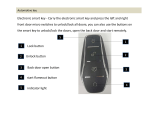
TABLE OF CONTENTS Index
4
3-4. Using the hands-free
phone system
(for cellular phone)
Making a phone call........... 291
Using the “SET UP” menu
(“Bluetooth” menu)........... 296
Using the “SET UP” menu
(“Phone” menu)................ 302
3-5. Using the interior lights
Interior lights list ................. 308
• Interior light ...................... 310
• Personal lights ................. 310
• Personal/interior lights...... 311
3-6. Using the storage features
List of storage features....... 312
• Glove box......................... 313
• Console box..................... 313
• Cup holders...................... 315
• Auxiliary boxes................. 318
• Bottle holders................... 320
3-7. Other interior features
Sun visors .......................... 321
Vanity mirrors..................... 322
Clock.................................. 323
Ashtray............................... 324
Cigarette lighter.................. 325
Power outlet ....................... 326
Seat heaters....................... 327
Assist grips......................... 329
Floor mat............................ 330
Compass............................ 331
4-1. Maintenance and care
Cleaning and protecting
the vehicle exterior ........... 336
Cleaning and protecting
the vehicle interior ............ 338
4-2. Maintenance
Maintenance
requirements .................... 341
General maintenance......... 343
Emission inspection and
maintenance (I/M)
programs .......................... 346
4-3. Do-it-yourself maintenance
Do-it-yourself service
precautions....................... 347
Hood................................... 351
Positioning a floor jack........ 353
Engine compartment .......... 356
Tires.................................... 371
Tire inflation pressure......... 379
Wheels................................ 383
Air conditioning filter........... 386
Key battery ......................... 388
Checking and replacing
fuses................................. 392
Light bulbs.......................... 402
4
Maintenance and care




















